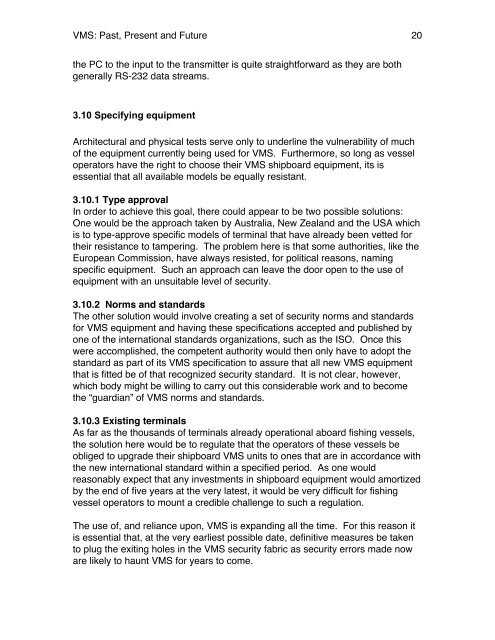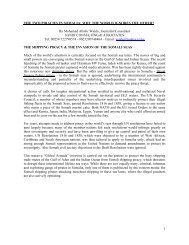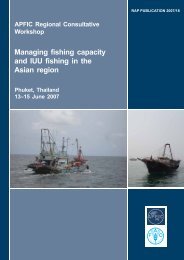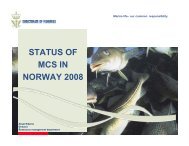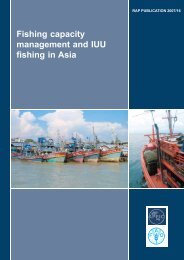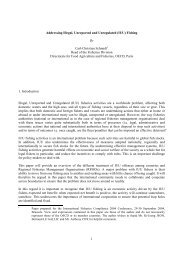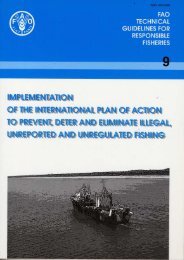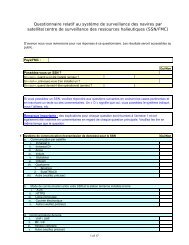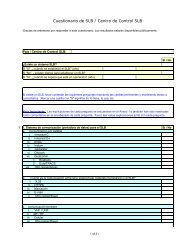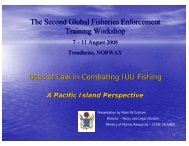Fishing Vessel Monitoring Systems: Past, Present and Future
Fishing Vessel Monitoring Systems: Past, Present and Future
Fishing Vessel Monitoring Systems: Past, Present and Future
You also want an ePaper? Increase the reach of your titles
YUMPU automatically turns print PDFs into web optimized ePapers that Google loves.
VMS: <strong>Past</strong>, <strong>Present</strong> <strong>and</strong> <strong>Future</strong> 20<br />
the PC to the input to the transmitter is quite straightforward as they are both<br />
generally RS-232 data streams.�<br />
3.10 Specifying equipment<br />
Architectural <strong>and</strong> physical tests serve only to underline the vulnerability of much<br />
of the equipment currently being used for VMS. Furthermore, so long as vessel<br />
operators have the right to choose their VMS shipboard equipment, its is<br />
essential that all available models be equally resistant.<br />
3.10.1 Type approval<br />
In order to achieve this goal, there could appear to be two possible solutions:<br />
One would be the approach taken by Australia, New Zeal<strong>and</strong> <strong>and</strong> the USA which<br />
is to type-approve specific models of terminal that have already been vetted for<br />
their resistance to tampering. The problem here is that some authorities, like the<br />
European Commission, have always resisted, for political reasons, naming<br />
specific equipment. Such an approach can leave the door open to the use of<br />
equipment with an unsuitable level of security.<br />
3.10.2 Norms <strong>and</strong> st<strong>and</strong>ards<br />
The other solution would involve creating a set of security norms <strong>and</strong> st<strong>and</strong>ards<br />
for VMS equipment <strong>and</strong> having these specifications accepted <strong>and</strong> published by<br />
one of the international st<strong>and</strong>ards organizations, such as the ISO. Once this<br />
were accomplished, the competent authority would then only have to adopt the<br />
st<strong>and</strong>ard as part of its VMS specification to assure that all new VMS equipment<br />
that is fitted be of that recognized security st<strong>and</strong>ard. It is not clear, however,<br />
which body might be willing to carry out this considerable work <strong>and</strong> to become<br />
the “guardian” of VMS norms <strong>and</strong> st<strong>and</strong>ards.<br />
3.10.3 Existing terminals<br />
As far as the thous<strong>and</strong>s of terminals already operational aboard fishing vessels,<br />
the solution here would be to regulate that the operators of these vessels be<br />
obliged to upgrade their shipboard VMS units to ones that are in accordance with<br />
the new international st<strong>and</strong>ard within a specified period. As one would<br />
reasonably expect that any investments in shipboard equipment would amortized<br />
by the end of five years at the very latest, it would be very difficult for fishing<br />
vessel operators to mount a credible challenge to such a regulation.<br />
The use of, <strong>and</strong> reliance upon, VMS is exp<strong>and</strong>ing all the time. For this reason it<br />
is essential that, at the very earliest possible date, definitive measures be taken<br />
to plug the exiting holes in the VMS security fabric as security errors made now<br />
are likely to haunt VMS for years to come.


